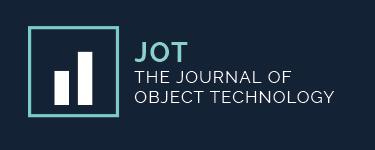About JOT
Mission
Published since 2002, the Journal of Object Technology welcomes manuscripts describing theoretical, empirical, conceptual, and experimental results in the area of software and language engineering, including
- programming paradigms
- software language engineering
- model-based and model-driven engineering
- requirement engineering
- software architecture
- software validation & verification
- software maintenance and evolution
- software analytics
- software development process and methodology
Submitted works will be assessed primarily on originality, significance, technical soundness, and quality of presentation. Contributions should conform to generally accepted practices for scientific papers with respect to organization, clarity, and style.
Besides technical contributions, JOT solicits papers about software tools and environments.
News
Oct 2022 | JOT welcomes Antonio Bucchiarone of Fondazione Bruno Kessler as a new member of the Editorial Board.
Indexing
JOT Journal is currently indexed by DBLP, Google Scholar, Microsoft Academic Search, SCIRUS, Scientific Commons, DOAJ, Index of IS Journals, and SCOPUS. JOT is registered under ISSN 1660-1769.
Continuous Publication Scheme
JOT uses a continuous publication scheme whereby regular papers, upon acceptance, are immediately added into a dynamic annual issue, with final DOI and other metadata.
New! JOT goes visual!
Published manuscripts can now be accompanied by a presentation video where the authors can illustrate their work. The videos are posted in the JOT channel on YouTube and grouped in playlists, one for each forthcoming issue.
The first playlist contains the presentations of papers published in the 16th European Conference on Modelling Foundations and Applications (ECMFA 2020) Special Theme that features 14 videos.
Platinum Open Access
JOT is open-access and completely free to both readers and authos (“platinum” model). This model has been JOT’s model ever since the journal’s visionary creation in 2002 and applies to all contributions (available under the Creative Commons license).

Current Volume
Volume 24, no. 2 (May 2025)
The 21st European Conference on Modelling Foundations and Applications (ECMFA 2025)
Editorial
- Robbert Jongeling, Sébastien Mosser, Preface to the JOT special issue on the 21st European Conference on Modelling Foundations and Applications (ECMFA 2025), pp. 1-5, PDF, DOI.
Articles
- David Jaeger, Adam Lencses, Martin Fleck, Philip Langer, Dominik Bork, A Model Management Framework for Next-Generation Web-based Modeling Tools, pp. 2:1-14, PDF, DOI.
- Thomas Weber, Niklas D. Kuder, Thomas A. Völk, Jonas Schneider, Sebastian Weber, Anne Koziolek, Towards Modeling Inconsistencies in Production Workflows — An Experience Report, pp. 2:1-14, PDF, DOI.
- Haitam El Hayani, Benoit Combemale, Olivier Barais, Steffen Zschaler, Variability Exploration for Decision Making: Supporting Domain Experts in Configuring Business Processes, pp. 2:1-13, PDF, DOI.
- Issam Al-Azzoni, Reiko Heckel, Zobia Erum, Dynamic Role-Based Access Control Scenarios for Smart Contracts: Graph Rewriting for Testing Domain-specific Models, pp. 2:1-15, PDF, DOI.
- Michael Mulder, Petra van den Bos, Introducing automated testing to video game development via Behaviour-Driven Development, pp. 2:1-14, PDF, DOI.
- Mathijs Schuts, Jozef Hooman, Ivan Kurtev, Issam Tlili, Erik Oerlemans, Online Model-Based Testing Reusing Multiple Design Models in an Industrial Setting, pp. 2:1-14, PDF, DOI.
- Raghavendran Gunasekaran, Boudewijn Haverkort, Loes Kruger, Behavioral analysis of a digital twin using logging and model learning, pp. 2:1-14, PDF, DOI.
- Hiba Ajabri, Jean-Marie Mottu, Christian Attiogbé, Pascal Berruet, Navigating the trace of executable domain specific languages through a trace domain query language, pp. 2:1-15, PDF, DOI.
- Sanjeev Sun Shakya, Qusai Ramadan, Julian Flake, Alexander Peikert, Support for Model-Based Data Sovereignty Analysis, pp. 2:1-14, PDF, DOI.
- Mauro Dalle Lucca Tosi, Javier Luis Cánovas Izquierdo, Jordi Cabot, A Metascience Study of the Low-Code Scientific Field, pp. 2:1-14, PDF, DOI.
- Georg Hinkel, Bodo Igler, An internal DSL for graphical modeling tools based on GLSP, pp. 2:1-14, PDF, DOI.
- Aaron Conrardy, Jordi Cabot, Alfredo Capozucca, User Modeling in Model-Driven Engineering: A Systematic Literature Review, pp. 2:1-14, PDF, DOI.
- Lars Fischer, Hendrik Kausch, Bernhard Rumpe, Max Stachon, Sebastian Stüber, Lucas Wollenhaupt, Methodical and Formally Verified Model-Driven Architecture Refactoring, pp. 2:1-14, PDF, DOI.
- Victor Campanello, Shariq Shahbaz, Vladislav Indykov, Daniel Strüber, On the Use of GPT-4 in the Reverse Engineering of Class Diagrams, pp. 2:1-14, PDF, DOI.
- Kevin Lano, Shekoufeh Rahimi, Zishan Rahman, Using MDE to support sustainable re-engineering, pp. 2:1-14, PDF, DOI.
